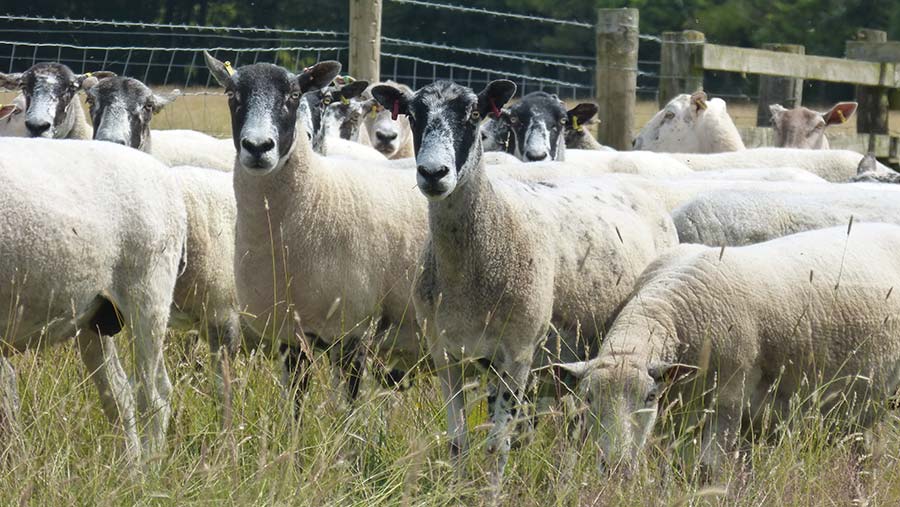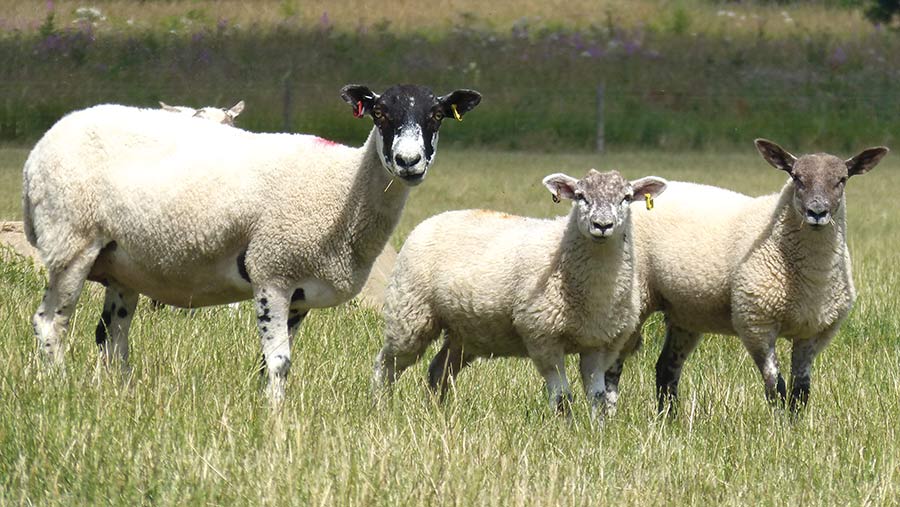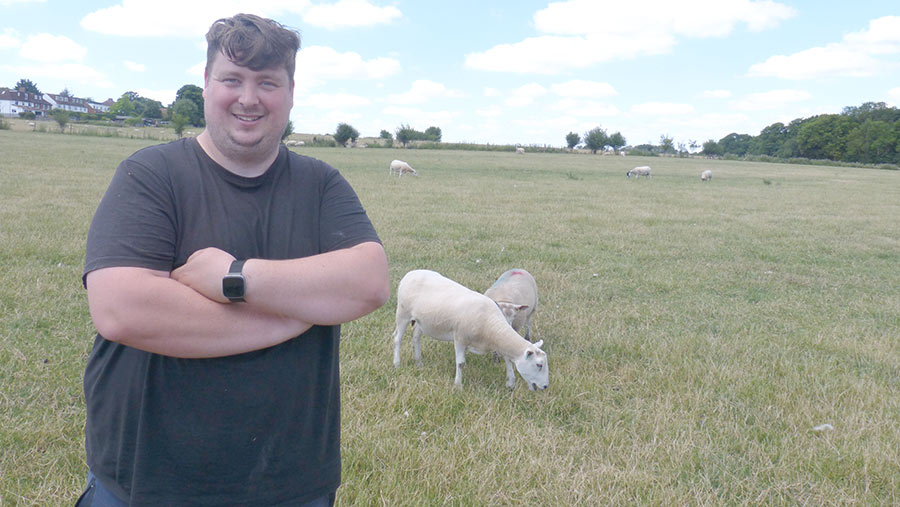College flock pits Mules against terminal crosses
 © MAG/Michael Priestley
© MAG/Michael Priestley Early results from a trial at a leading vet college farm comparing Mules with three-quarter and seven-eighths-bred continental lowland ewes have shown one breed could have a slight edge.
The Royal Veterinary College (RVC), which owns Boltons Park Farm, near Potters Bar, Hertfordshire, has found the continental-type “lowland” ewes have, unsurprisingly, produced better carcasses.
But the North of England Mules have had better weight gain and lower lamb mortality.
Farm manager Graeme Webster, along with shepherd Aimee Bailey, started a breed comparison trial this year to see which sheep would come out on top.
See also: Mule breeder builds flock health to keep market share
“We are trying to do everything we can on the management and diet side to really see what we can get out of the sheep,” says Mr Webster (see below, Boltons Park Farm: High input system).
While profit is an aim at the farm, with school visits and outreach activities taking place each year, along with more than 16,000 student teaching hours a year on the farm, day-to-day management has more staffing and planning challenges than a typical lowland sheep flock.
Farmers Weekly will follow progress and see which breed ends up on top.
Farm Facts: Boltons Park Farm
- 400 breeding ewes plus followers
- Texel, Suffolk and Beltex cross Charollais terminal sires
- Sheep fit in around 100-head dairy unit run by Charlie Verity and Sophie McCormack
- 142ha (350 acres) of grassland, of which 86ha (212 acres) is permanent pasture
- 56ha (138 acres) improved grassland in arable rotation
- 24.2ha (60 acres) of rye, vetch, black oats, and stubble turnips follow maize
- 12ha (30 acres) of lucerne used to fatten lambs after two to three silage cuts
- Lambs sold through Melton Mowbray and Anglia Quality Meats

© MAG/Michael Priestley
Breeds
The two flocks are North Country Mules – a Swaledale sired by a Bluefaced Leicester – and continental ewes, which are a mix of Suffolk-, Texel- and Charrollais-crosses home-bred from Mules.
The farm runs a system producing lambs from terminal sires, and is using the data to see whether it is worthwhile retaining any continental-cross sheep, following improvements in the farm’s replacement sourcing policy for Mules.
Historically, about 60 ewe lambs were kept from the first draw of lambs and a similar number of North of England Mules was bought in from an agent.

Graeme Webster @ MAG/Michael Priestley
Biosecurity
However, this resulted in a maedi visna (MV) outbreak, lameness issues and sheep scab, all things that Mr Webster has controlled since he started managing the flock in 2019.
“When I first came, we bled the entire flock to test for MV and it was in about 5% of the ewes. We tested thinner sheep for Johne’s and checked for caseous lymphadenitis (CLA) as well, but the main issue was MV.
“The issue was buying from unknown multiple sources – we had a group of 100 Mule shearlings and 10 different UK numbers.”
The breed comparison trial is going to look at Mules bought from Cumbrian breeder Jonathan Hodgson, High Borrans, near Ambleside, who is monitoring his sheep for MV.
Mr Webster says having a known source of sheep and a breeder he trusts is important.
He believes Mules are potentially good sheep but cannot realise their potential if they are limited by disease, which is why a strict quarantine protocol is in place sourcing from a single flock (see Quarantine and biosecurity policy).
Quarantine and biosecurity policy
- Sheep are taken to an isolated quarantine field on arrival, away from the rest of the flock, given one of the two newest wormer groups (orange or purple) to clean their worm burden and run through a 5% formalin foot-bath
- After at least four weeks, they move on to ground previously occupied by sheep, to introduce them to worms
- After one week a proportion of the sheep are blood-sampled for sheep scab and tested for fluke and treated as required
- After two more weeks, the sheep are run through the foot-bath again
- Before moving to further grazing, the ewes’ feet and teeth are checked
- Sheep are not plunge-dipped at Boltons Park Farm due to the amount of demonstration work and hands-on teaching that takes place
- After shearing the replacements are blood-tested for MV through Hammond Vets
- Bought-in replacements are kept separate from the rest of the flock until tupping
Results so far
At scanning, the twinning rate for the shearling Mules was 3% ahead of the shearling continentals, at 70%.
Lambing inside with the aid of veterinary students means there is plenty of labour to help with fostering, so the system does not rely on a high twinning rate.
“The continentals scanned better,” Mr Webster says. “But mortality and barren rates were lower in the Mules, so the actual numbers of lambs sold will be interesting to see.”
When all lambs are slaughtered, an economic income on each ewe will be calculated to determine which sheep are earning the business most money.
Scanning results |
||||
|
Performance indicator |
Early lowlands |
Early Mules |
Shearling Lowlands |
Shearling Mules |
|
Birth weight (kg) |
4.46 |
4.61 |
4.78 |
4.56 |
|
Eight-week weight (kg) |
20.14 |
21.13 |
21.2 |
21.70 |
|
Mortality (%) (birth to eight weeks) |
6 |
3 |
5.5 |
5 |
|
Daily liveweight gain (g/day) |
0.280 |
0.295 |
0.293 |
0.306 |
|
Grade (%) |
17 hit E or U grade 35.3 hit R2 39 HIT R3L 11.7 missed specification |
1.6 hit an E or U 48 R2 40 R3L 24 missed specification |
Some lambs still to slaughter |
Some lambs still to slaughter |
|
Scanning rate (%) |
213 |
192 |
164 |
197 |
|
Barren rate (%) |
6 |
3 |
7.5 |
5 |
|
Twin rate (%) |
54 |
64 |
67 |
70 |
|
Singles/triplets (%) |
7.5/33 |
17/15 |
22/2 |
8/16 |
Boltons Park Farm: High input system
Spring
- An early flock is lambed from 14 February for two-and-a-half weeks. Lambs were weaned at 14 weeks this year.
- Late lambers are given two cycles and lamb from mid-March. This year lambs were weaned at 12 weeks old.
- Split lambing allows vet students to get some hands-on practice before going to farms for lambing work experience. The later lambing group is for students unable to find work experience placements.
Summer
- Silage ground is prioritised for the dairy herd, but lambs can be weaned onto aftermaths with creep to get them away as fast as possible.
- Ram lambs are all kept entire to help with growth rates and minimise welfare issues. All lambs are creep-fed to try to get them sold before harvest starts.
- A comprehensive health plan sees lame ewes culled after two chances, and two formalin foot-baths are regularly taken to yards or fields on days when sheep are penned and worked with. The flock is vaccinated for enzootic and toxoplasmosis abortion, clostridial disease and foot-rot. Fewer than 10 sheep have been foot-trimmed in the past two years (due to non-infectious causes). Lameness has fallen from 30-40% in 2020 to 2-3% in 2022.
Winter
- Ewes are stocked very lightly over the grassland until housing four to five weeks before lambing
- A total mixed ration of grass silage and blend is fed, with blend increased as lambing date moves closer
- Metabolic blood profiles are taken two weeks after the ewes have gone onto the diet, to check energy and protein levels, with diets adjusted if necessary
- This year the ration was very high energy (14.7-19.2ME), so straw was used to dilute haylage/silage rations until four weeks pre-lambing.
